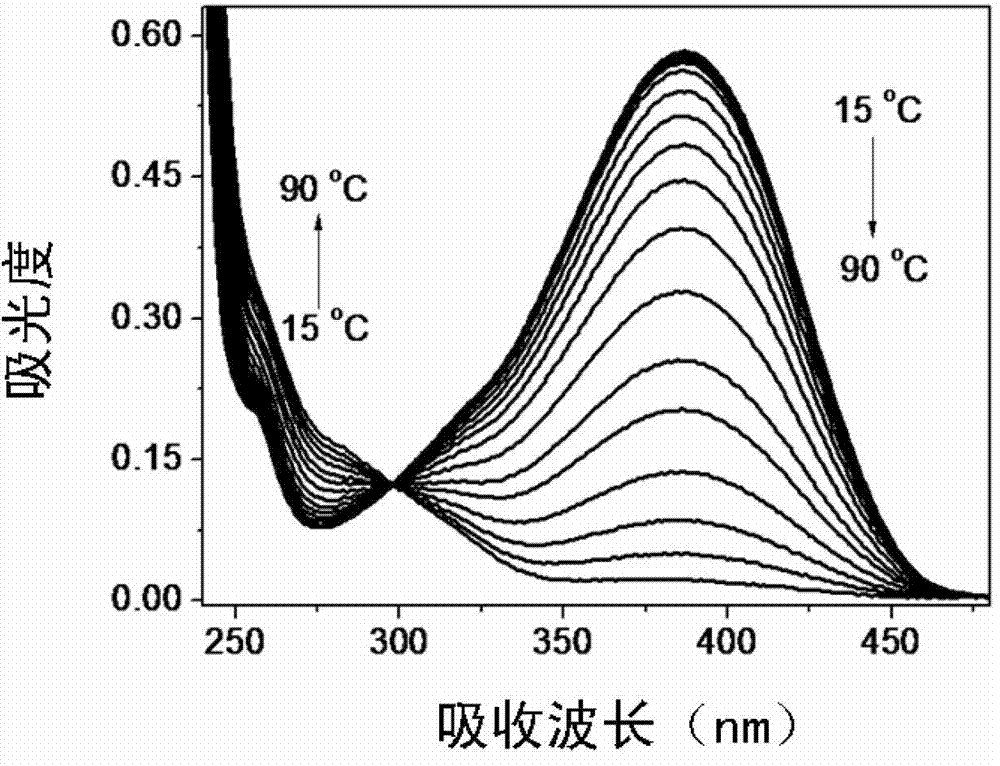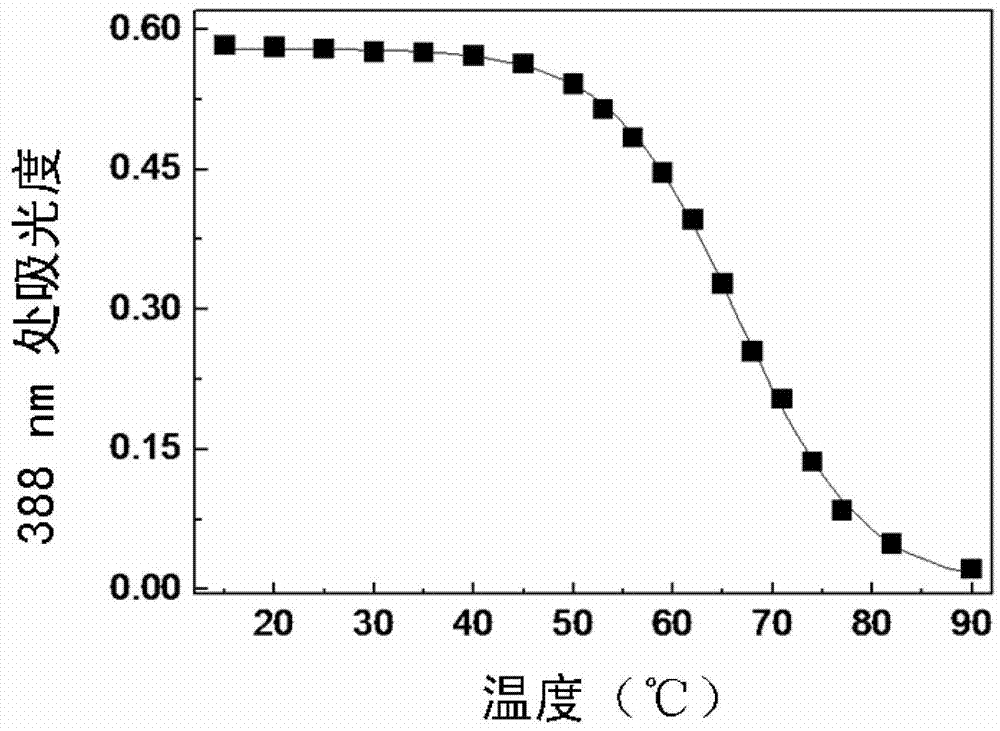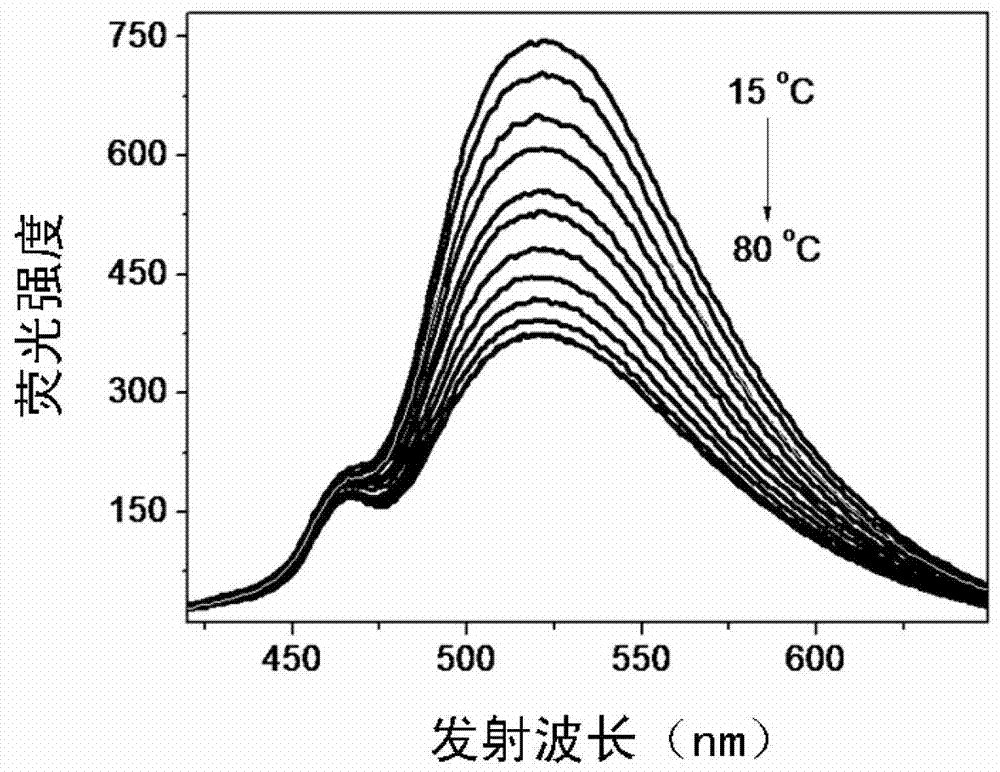Method for preparing hemicyanine plastocyanin temperature-sensitive molecular optical probe containing electron-donating group
A technology of electron-donating groups and optical probes, which is applied in the field of preparation of temperature-sensitive molecular optical probes, can solve problems such as limited applications, and achieve rapid measurement and monitoring effects
- Summary
- Abstract
- Description
- Claims
- Application Information
AI Technical Summary
Problems solved by technology
Method used
Image
Examples
Embodiment 1
[0023] Example 1: Synthesis of 2-methoxyphenylvinylindoline tetrafluoroborate (3a)
[0024]
[0025] Weigh 0.34g (0.0025mol) of o-methoxybenzaldehyde and place it in a 50mL round bottom flask, add 0.65g (0.0025mol) of N-methyl-2,3,3-trimethyl-3H-indolium iodide mol) and 25mL absolute ethanol, oil bath, stirring, react at 100°C for 12 hours, then add 0.41g potassium tetrafluoroborate, react for 2 hours. The solution was spin-dried, the solid was dissolved in 5 mL of DMF, the inorganic salt was removed by filtration, the obtained solution was spin-dried, and the solid was recrystallized with 10 mL of ethanol to obtain 0.57 g of red crystals with a yield of 72%. mp.212-214°C; ESI: m / z[M-BF 4 - ] + :292.1696; 1 H NMR (CDCl 3 ,400MHz), δ (ppm) 1.87 (s, 6H), 4.03 (s, 3H), 4.47 (s, 3H), 7.01-6.99 (d, J=8.4Hz, 1H), 7.21-7.17 (t, J =7.6Hz, 1H), 7.60-7.58 (t, J=5Hz, 4H), 7.70-7.69 (d, J=7.2Hz, 1H), 7.87-7.83 (d, J=16.4Hz, 1H), 8.40- 8.38 (d, J=8Hz, 1H), 8.64-8.60 (d, J=16.4Hz,...
Embodiment 2
[0033] Example 2: Synthesis of 3-methoxyphenylvinylindoline tetrafluoroborate (3b)
[0034]
[0035] Weigh 0.36g (0.0026mol) of m-methoxybenzaldehyde and place it in a 50mL round bottom flask, add 0.65g (0.0026mol) of N-methyl-2,3,3-trimethyl-3H-indolium iodide mol) and 25mL absolute ethanol, oil bath, stirring, react at 100°C for 12 hours, then add 0.37g potassium tetrafluoroborate to the flask, and react for 2 hours. The solution was spin-dried, the solid was dissolved in 5 mL of DMF, the inorganic salt was removed by filtration, the obtained solution was spin-dried, and the solid was recrystallized with 10 mL of ethanol to obtain 0.98 g of purple-black crystals with a yield of 98%. m.p.192-194°C; ESI: m / z[M-BF 4 - ] + Calculated value: 292.17; Measured value: 292.1696; 1 H NMR (CDCl 3 ,400MHz), δ (ppm) 1.89 (s, 6H), 4.03 (s, 3H), 4.53 (s, 3H), 7.16-7.14 (t, J=4.2Hz, 1H), 7.46-7.42 (t, J =8Hz, 1H), 7.61-7.59 (d, J=6Hz, 4H), 7.69-7.61 (d, J=1.6Hz, 2H), 7.86-7.82 (d, ...
Embodiment 3
[0037] Example 3: Synthesis of 4-methoxyphenylvinylindoline tetrafluoroborate (3c)
[0038]
[0039] Weigh 0.36g (0.0026mol) of p-methoxybenzaldehyde and place it in a 50mL round bottom flask, add 0.79g of N-methyl-2,3,3-trimethyl-3H-indolium iodide ( 0.0026mol) and 25mL absolute ethanol, oil bath, stirring, react at 100°C for 12 hours, then add 0.35g potassium tetrafluoroborate to the flask, and react for 2 hours. The solution was spin-dried, the solid was dissolved in 5 mL of DMF, the inorganic salt was removed by filtration, the obtained solution was spin-dried, and the solid was recrystallized with 10 mL of ethanol to obtain 0.96 g of red crystals with a yield of 96%. mp.208-210°C; ESI: m / z[M-BF 4 - ] + :292.1696; 1 H NMR (CDCl 3 ,400MHz), δ (ppm) 1.82 (s, 6H), 3.89 (s, 3H), 4.41 (s, 3H), 7.05-7.03 (d, J=8.8Hz, 2H), 7.52-7.51 (m, J =2.3Hz, 2H), 7.56-7.55 (t, J=2.4Hz, 2H), 7.75-7.71 (d, J=9.6Hz, 1H), 8.21-8.14 (m, J=9.2Hz, 3H); 13 C NMR (DMSO-d 6 ,100MHz), δ(ppm)...
PUM
 Login to View More
Login to View More Abstract
Description
Claims
Application Information
 Login to View More
Login to View More - Generate Ideas
- Intellectual Property
- Life Sciences
- Materials
- Tech Scout
- Unparalleled Data Quality
- Higher Quality Content
- 60% Fewer Hallucinations
Browse by: Latest US Patents, China's latest patents, Technical Efficacy Thesaurus, Application Domain, Technology Topic, Popular Technical Reports.
© 2025 PatSnap. All rights reserved.Legal|Privacy policy|Modern Slavery Act Transparency Statement|Sitemap|About US| Contact US: help@patsnap.com



